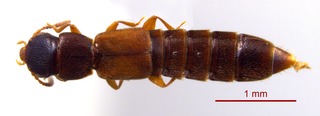
The rove beetles are a family (Staphylinidae) of beetles, primarily distinguished by their short elytra that typically leave more than half of their abdominal segments exposed. With over 66,000 species in thousands of genera, the group is the largest family in the beetle order, and one of the largest families of organisms. It is an ancient group, with fossilized rove beetles known from the Triassic, 200 million years ago, and possibly even earlier if the genus Leehermania proves to be a member of this family. They are an ecologically and morphologically diverse group of beetles, and commonly encountered in terrestrial ecosystems.

Scydmaeninae are a subfamily of small beetles, commonly called ant-like stone beetles or scydmaenines. These beetles occur worldwide, and the subfamily includes some 4,500 species in about 80 genera. Established as a family, they were reduced in status to a subfamily of Staphylinidae in 2009

The devil's coach-horse beetle is a species of beetle belonging to the large family of the rove beetles (Staphylinidae). It was originally included in the genus Staphylinus in 1764,and some authors and biologists still use this classification.

The Omaliinae are a subfamily of the Staphylinidae, rove beetles.

Pselaphinae are a subfamily of beetles in the family Staphylinidae, the rove beetles. The group was originally regarded as a separate family named Pselaphidae. Newton and Thayer (1995) placed them in the Omaliine group of the family Staphylinidae based on shared morphological characters.

The Paederinae are a subfamily of the Staphylinidae, rove beetles. As of 2024, three tribes are accepted within this subfamily: Lathrobiini, Paederini, and Pinophilini. This insect is commonly known as Tomcat.

The Osoriinae are a subfamily of beetles in the family Staphylinidae, the rove beetles. They are found mainly in tropical and subtropical regions.

Dasycerinae is a subfamily of rove beetles. Dasycerinae currently only contains 1 extant genus and 3 extinct genera.

Steninae is a subfamily of Staphylinidae.

The Aleocharinae are one of the largest subfamilies of rove beetles, containing over 12,000 species. Previously subject to large-scale debate whether the subfamily deserved the familial status, it is now considered one of the largest subfamilies of rove beetles.
The Empelinae are a subfamily of rove beetles; their biology is virtually unknown. Their anatomy and ecology resemble many rove beetles.

The Euaesthetinae are a subfamily of the Staphylinidae (Coleoptera) containing six tribes.

The Habrocerinae are a subfamily of the Staphylinidae, rove beetles.

The Leptotyphlinae are a subfamily of the Staphylinidae, rove beetles. They are very small, less than 1.8 mm long, and are eyeless and wingless. These beetles appear to have seven abdominal segments, and 3-3-3 is their tarsal formula. They are found in leaf litter or deep soil, possibly as predators of mites, collembola, and other soil arthropods. Nine genera and 13 species are known from North America, in western states and Florida, but they may be more widespread.

The Megalopsidiinae are a monogeneric subfamily of the Staphylinidae, which includes only the genus Megalopinus. They have large eyes, antennae with distinct di- or trisegmented clubs. The tarsal formula is 5-5-5. They have unique elongated processes at the anterior margin of the labrum. They are found in decaying trees and fungus-infested logs. Four species are found in North America: Megalopinus caelatus, Megalopinus punctatus, Megalopinus rufipes and Megalopinus lingafelteriMainda, 2023.

The Micropeplinae are a subfamily of the Staphylinidae, rove beetles. Their antennae have 9 segments with single-segmented clubs. The tarsal formula is 4-4-4. They are found in leaf litter, near lake shores and marshy areas, in mammal and bird nests, probably as saprophages or mold feeders. In North America, two genera are known Kalissus LeConte 1874 and Micropeplus Latreille, with 14 widespread species.

Phloeocharinae is a subfamily of beetles in the family Staphylinidae.

Piestinae are a subfamily of Staphylinidae.

Proteininae is a subfamily of Staphylinidae.

Rugilus rufipes is a species of rove beetle in the family Staphylinidae. It is commonly found across Europe and parts of North America. These beetles are known for their slender bodies and distinctive red legs, which give the species its name.



















